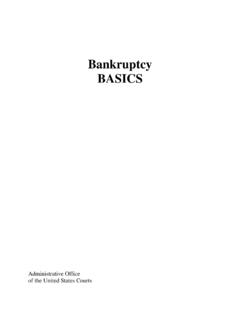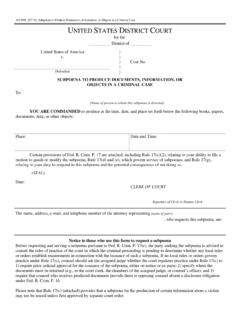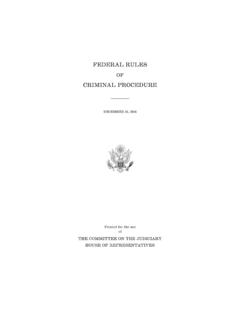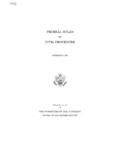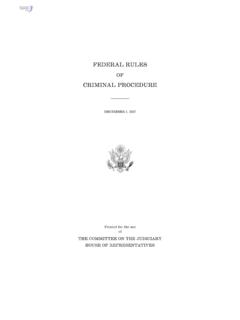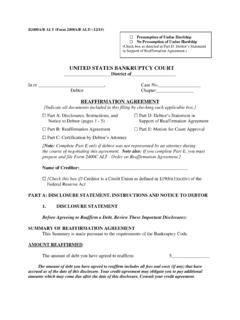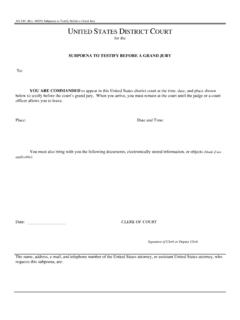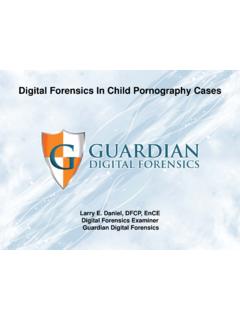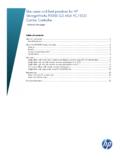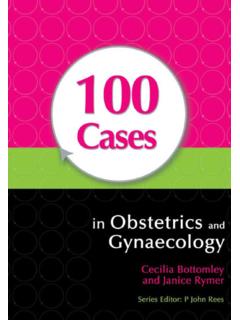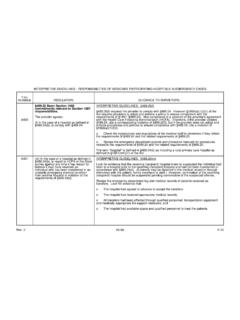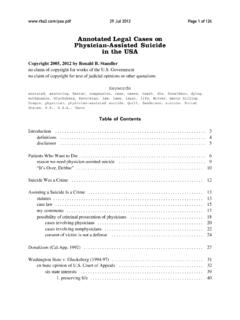Transcription of Sealed Cases in Federal Courts
1 Sealed Cases in Federal Courts Federal Judicial Center October 23, 2009 This Federal Judicial Center publication was undertaken in furtherance of the Center s statutory mission to conduct and stimulate research and development for the improvement of judicial administration. The views expressed are those of the authors and not necessarily those of the Federal Judicial Center. Sealed Cases in Federal Courts ii Contents Method, 1 Sealed Civil Cases , 4 Qui Tam Actions, 5 Sealed Pending Government s Decision Whether to Intervene, 6 Unsealed Following Government s Making Its Election, 6 Unsealed Without a Filing of the Government s Election Notice, 6 Sealed Pending Settlement, 6 Stayed, 6 Transferred, 6 Dismissed, 7 Filed Under the Miller Act, 7 Temporary Restraining Orders, 7 Habeas Corpus Actions and Prisoner Petitions, 7 Other Cases Concerning Minors, 8 Cases Concerning Childhood Sexual Abuse, 8 Actions Involving National Secrets, 8 case Sealed to Protect Juror s Anonymity, 8 Cases Involving Confidential Business Information, 8 Cases Sealed to Protect Physicians Reputations.
2 9 Cases Concerning Medical Information, 9 Cases Concerning Confidential Settlement Agreements, 10 Still Sealed , 10 Unsealed Upon Our Bringing the case to the court s Attention, 10 Cases Concerning Other Confidential Agreements, 11 case Sealed to Protect a Credit Rating, 12 Other Cases Sealed Because the Parties Wanted Them Sealed , 12 Pro Se Cases , 14 Extradition, 14 Forfeitures and Seizures, 14 Grand Jury Matters, 14 Other Sealed Civil Cases Often Given Other case Types, 14 Cases Sealed to Prevent Filing in the Wrong case , 14 Cases Sealed Because of Filing Errors, 15 Cases Apparently Sealed in Error, 15 Cases Not Counted as Sealed But Regarded by the Courts as Sealed , 16 Cases That Became Unsealed After We First Looked at the Data, 16 Sealed Cases in Federal Courts iii Sealed Criminal Cases .
3 17 Sealed Indictments, 17 Fugitives, 18 Still Sealed Because Some Defendants Are Fugitives, 18 Transferred Before the Defendants Appeared, 18 Dismissed Before the Defendants Appeared, 18 Juvenile Prosecutions, 18 Misdemeanor Drug Cases , 18 Cooperators, 19 Transfers of Jurisdiction, 19 Grand Jury Matters, 19 Warrant-Type Cases , 19 Sealed to Protect the Victims, 19 Sealed to Protect Trade Secrets, 20 High-Profile Defendant, 20 Attorney Discipline, 20 Other, 20 Sealing Function Used for Cases That Are Not Sealed , 21 Cases That Should Not Have Been (Still) Sealed , 21 Cases Not Counted as Sealed But Regarded by the Courts as Sealed , 21 Cases That Became Unsealed After We First Looked at the Data, 21 Sealed Magistrate Judge Cases , 21 Warrant-Type Applications, 22 Sealed Criminal Complaints, 22 Grand Jury and CJA Matters, 22 Other Matters, 22 Sealed District court Miscellaneous Cases , 23 Warrant-Type Applications, 23 Grand Jury and CJA Matters, 23 Assistance with Foreign Cases , 24 Forfeitures and Seizures, 24 Other Matters, 24 Other District court Cases , 26 Multidistrict and Other Consolidations, 26 Petty Offense Cases , 26 CVB Cases , 26 Grand Jury Cases , 26 Material Witness Cases , 26 Habeas Corpus Cases , 26 Prisoner Cases , 26 Transfers of Jurisdiction.
4 26 Search and Seizure Warrant Cases , 27 Wiretaps, 27 Sealed Cases in Federal Courts iv Pen Registers, 27 Foreign Judgments, 27 Registrations of Judgment, 27 Out-of-City Judge Cases , 27 Attorney Discipline and Administrative Proceedings, 27 Sealed case Logs, 27 case Shells to Facilitate Electronic Filing, 27 Noncompliance Cases , 28 Sealed Appeals, 28 Number of Sealed Cases , 28 Types of Sealed Cases , 28 Procedures and Records, 29 Bankruptcy court Cases , 30 Conclusion, 30 Civil Cases , 30 Criminal Cases , 31 Other District court Records, 31 Appeals, 31 Bankruptcy court Cases , 31 Answers to Research Questions, 32 1 Sealed Cases in Federal Courts Tim Reagan George Cort Federal Judicial Center* October 23, 2009 On April 4, 2008, the Judicial Conference s standing Committee on Rules of Practice and Proce-dure (Hon.)
5 Lee Rosenthal, Tex., chair) asked the Federal Judicial Center to conduct, for its subcommittee on Sealed Cases (Hon. Harris Hartz, 10th Cir., chair), a study of completely Sealed Cases in the Federal district Courts , bankruptcy Courts , and Courts of appeals. On July 11, 2008, we described a method for determining what kinds of Cases are Sealed . On November 14, 2008, the subcommittee chair asked us to expand our research to investigate how whole Cases come to be Sealed . These are the research questions: 1. What kinds of Cases are Sealed ? 2. How is sealing requested? 3. How is sealing decided? a. Who decides? b. Is there an opportunity for public challenge? 4. Is there a record of what is Sealed and why? a. Is there a public record?
6 B. Is there a record on the docket sheet? 5. Are Cases unsealed when they no longer need to be Sealed ? Method We decided to examine all Cases filed in 2006. A calendar-year filing cohort is suitable for this study, because Courts incorporate the filing year into case numbers, and a complete calendar-year filing cohort affords accounting for complete sequences of case numbers. The more recent the Cases we look at, the more likely information about them will be available electronically; because we began the study early in 2008, selecting Cases filed in 2006 avoided Cases Sealed only for very short periods of time soon after their filing. Almost all district Courts entered records for their 2006 Cases in CM/ECF. Some districts did not enter records for some or all magistrate judge or miscellaneous Cases ; sometimes Sealed Cases were specially omitted from CM/ECF.
7 But if a case record is entered into CM/ECF, the Center usually has access to its docket sheet information, even if it is Sealed . The subcommittee decided that we should study completely Sealed Cases , not partially Sealed case files. Sealed Cases usually are tagged as Sealed in CM/ECF, and queries for them in PACER usually result only in messages that the Cases are Sealed . We did not count as Sealed Cases those with every document Sealed and only highly redacted docket sheets available on PACER, because a method different from the one we used would be necessary to find all such Cases . A very small number of districts make available on PACER * For assistance with this project, we are grateful to Jared Bataillon, Tyeika Hartsfield, Kevin Jolly, and Angelia Levy.
8 Only the authors had access to Sealed information. Sealed Cases in Federal Courts 2 highly redacted docket sheets for Sealed Cases ; we followed our usual procedures and regarded such Cases as not It recently became Judicial Conference policy to post redacted docket sheets for Sealed Cases , but Courts generally did not follow this practice for Cases filed in 2006. Using CM/ECF data, we identified every case filed in every district in 2006, and we identi-fied which Cases were Sealed when we looked at the database. We asked the district clerks if the Cases we thought were Sealed were in fact all of their Sealed Cases , and we asked the clerks to ac-count for any case numbers that appeared to be missing in the database. If a district did not put some or all of its 2006 Cases in CM/ECF, we asked the clerk to tell us what case numbers were used and which Cases were Sealed .
9 Clerks very often delegated answering our questions to mem-bers of their staffs. The four basic case types in district Courts are civil ( cv ), criminal ( cr ), magistrate judge ( mj ), and miscellaneous ( mc ). Some districts use civil case numbers for Cases that other dis-tricts would give miscellaneous case numbers; some districts use criminal case numbers for Cases that other districts would give magistrate judge case numbers; and there are other variations in how districts assign case numbers. Because an important part of our method was accounting for all case numbers assigned to Cases filed in 2006, and because case type is an important part of the case number, we decided to honor districts individual case -type classifications. So search war-rants, for example, are regarded as magistrate judge Cases in districts that give them mj case numbers, miscellaneous Cases in districts that give them mc case numbers, and criminal Cases in districts that give them cr case numbers.
10 Many Sealed civil Cases are qui tam actions, almost always filed under the False Claims Act, which requires the case to be Sealed until the government decides whether to intervene. Docket entries to which we have access usually make such Cases readily apparent. We confirmed with the clerks whether Sealed civil Cases were in this category, and then we wrote to the presiding judges to inquire (1) if the Cases were still pending and awaiting decisions by the government whether to intervene, and (2) if not, why the Cases were still Sealed . Using docket information and clerk inquiries, we also were able to classify Sealed civil Cases into four other categories: grand jury matters, seizures and forfeitures, Cases involving minors, and others. For Cases in the last category, we wrote to the presiding judges to inquire why, in gen-eral terms, the Cases were Sealed .
